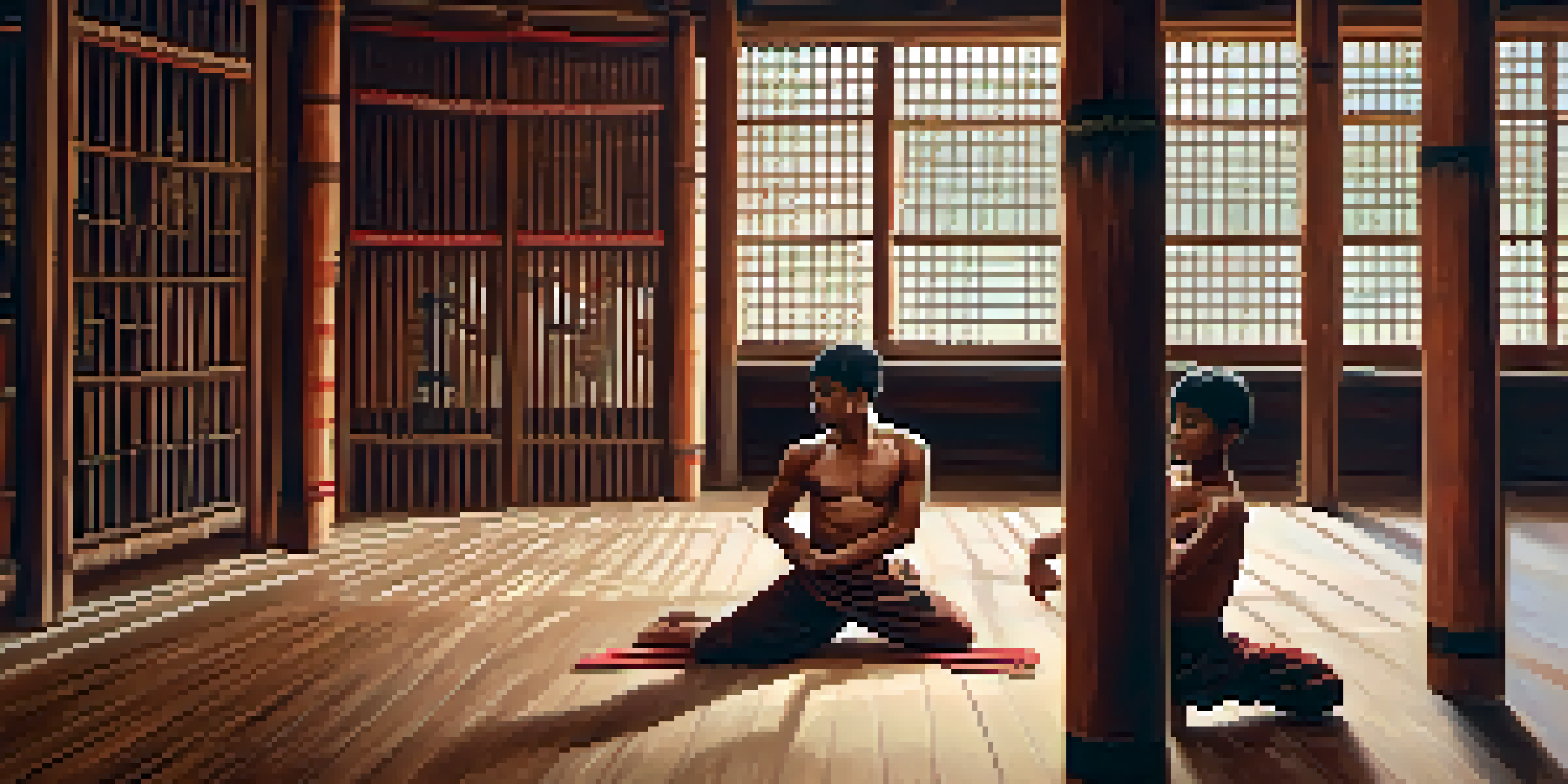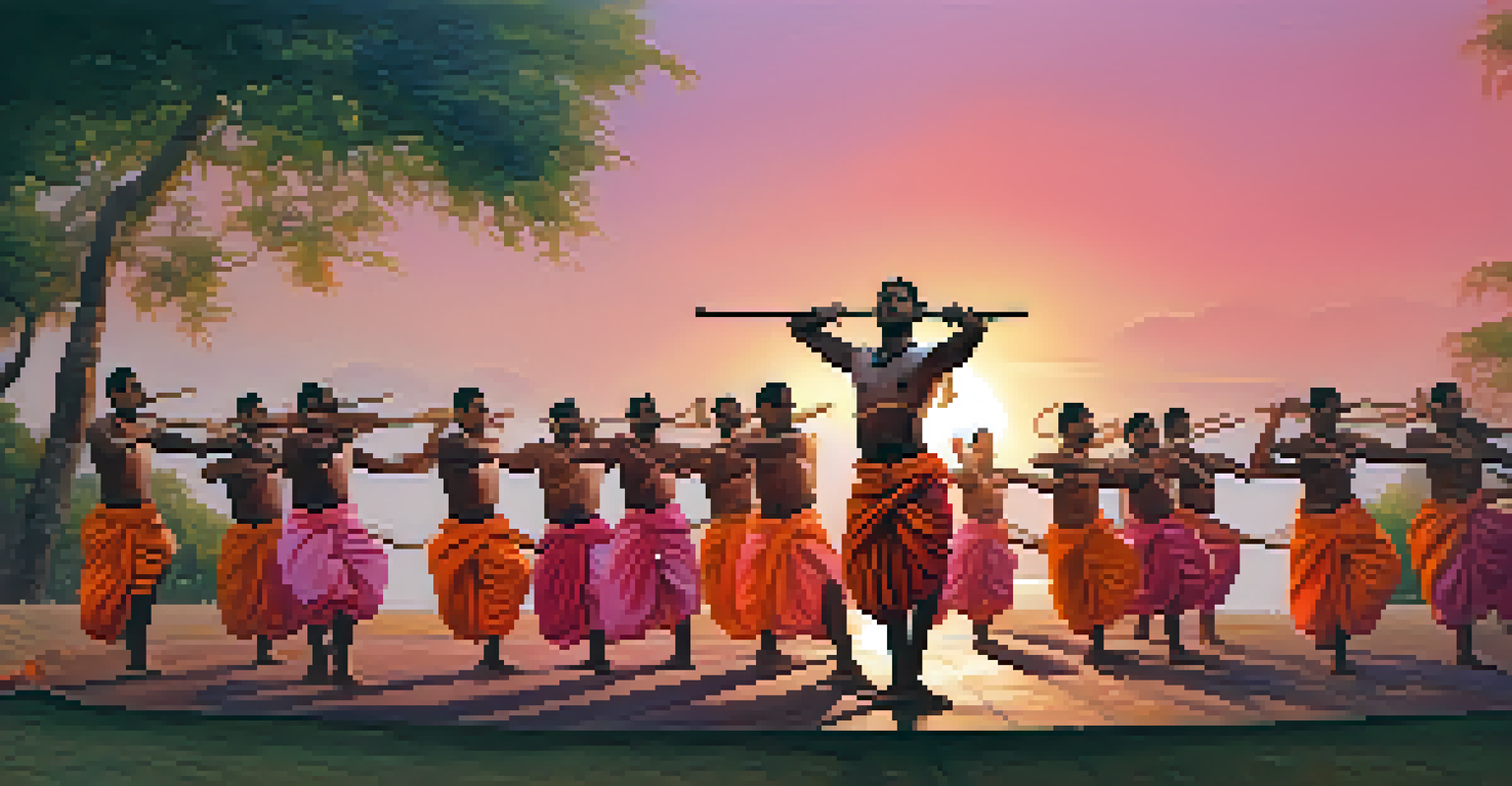Ancient Indian Texts: The Roots of Kalaripayattu Techniques

Understanding Kalaripayattu: A Historical Overview
Kalaripayattu is one of the oldest martial arts in the world, originating from Kerala, India. It combines physical prowess with philosophical teachings, rooted in ancient Indian texts. This martial art not only focuses on combat techniques but also emphasizes the importance of discipline and respect.
Martial arts is not about the physical strength but about the mental discipline and focus you develop along the way.
The history of Kalaripayattu is interwoven with the cultural tapestry of India, reflecting the values and beliefs of its time. Ancient warriors practiced it not just for self-defense, but for spiritual and physical development. This historical context helps us appreciate the depth and significance of Kalaripayattu.
As we explore the techniques of Kalaripayattu, it's essential to recognize how they are influenced by ancient texts like the Vedas and Upanishads. These scriptures laid the groundwork for understanding the body, mind, and spirit, which are crucial components of this martial art.
The Role of Ancient Indian Texts in Kalaripayattu
Ancient Indian texts serve as the backbone of Kalaripayattu, offering insights into its techniques and philosophies. Texts such as the 'Dhanur Veda,' which focuses on archery and martial skills, provide a framework for understanding how to approach combat. This text, along with others, emphasizes the significance of training and mastery.

These texts not only detail physical techniques but also prescribe ethical guidelines for practitioners. The principles of respect, humility, and honor found in these scriptures are integral to Kalaripayattu. They remind practitioners that martial arts is as much about character building as it is about physical strength.
Kalaripayattu's Rich Historical Roots
Kalaripayattu is one of the oldest martial arts, deeply intertwined with ancient Indian texts that emphasize both combat skills and philosophical teachings.
Moreover, the teachings from these ancient texts encourage a holistic view of combat, integrating mind, body, and spirit. This synchronization is what sets Kalaripayattu apart from many other martial arts, making its connection to ancient wisdom crucial.
Key Techniques Derived from Ancient Texts
Kalaripayattu techniques are diverse, drawing from various ancient Indian texts that outline specific postures and movements. For example, the 'Asanas' mentioned in yoga scriptures influence many stances in Kalaripayattu. Each movement is designed not just for effectiveness but also for enhancing the practitioner's agility and strength.
The practice of martial arts is a journey of self-discovery, where the body becomes a vehicle for the mind and spirit.
The 'Sutras' from the ancient texts emphasize the importance of breath control and meditation, which are vital for mastering Kalaripayattu. These elements help practitioners maintain focus and calmness during intense physical exertion. As such, breathing techniques are woven into the training regimen.
Additionally, the combat strategies outlined in ancient texts inform the tactical approaches used in Kalaripayattu. Understanding the philosophy of timing and distance, for instance, can often be traced back to these age-old scriptures, highlighting the profound connection between theory and practice.
Philosophical Underpinnings of Kalaripayattu
At its core, Kalaripayattu is more than a physical discipline; it is a philosophical journey rooted in ancient Indian thought. The principles of balance between body and mind reflect ideas expressed in texts like the Bhagavad Gita. This connection fosters a greater understanding of the self and one’s place in the universe.
Practitioners often find that engaging with these philosophical ideas enhances their training. Concepts such as 'Ahimsa' (non-violence) and 'Dharma' (duty) serve as guiding principles in their practice. This philosophical grounding cultivates a respectful and mindful approach to martial arts.
Philosophy Shapes Martial Practice
Core principles like 'Ahimsa' (non-violence) and 'Dharma' (duty) from ancient Indian philosophies enhance practitioners' approach to Kalaripayattu.
Furthermore, the spiritual aspects of Kalaripayattu are deeply tied to ancient Indian philosophies, emphasizing the importance of inner peace and self-awareness. These elements encourage practitioners to seek harmony within themselves, which ultimately reflects in their martial techniques.
The Influence of Ayurveda on Kalaripayattu Techniques
Ayurveda, the ancient Indian system of medicine, significantly influences Kalaripayattu, particularly in its approach to training and recovery. The ancient texts of Ayurveda provide insights into the body's energy systems, guiding practitioners on how to optimize their physical conditioning. This holistic perspective enhances both performance and longevity in martial arts.
Practitioners often learn about the importance of nutrition and lifestyle choices from Ayurvedic texts, understanding how these factors affect their energy levels and recovery. By incorporating Ayurvedic principles, they can tailor their training to suit their individual needs, promoting overall well-being.
Moreover, the therapeutic practices from Ayurveda, such as oil massages and herbal remedies, are often integrated into Kalaripayattu training. These practices help in preventing injuries and enhancing flexibility, ensuring that practitioners remain in peak physical condition.
Modern Interpretations of Ancient Techniques
As Kalaripayattu gains global recognition, modern interpretations of its ancient techniques are emerging. Contemporary practitioners often blend traditional methods with innovative training styles, making the art accessible to a wider audience. This evolution maintains the core principles while adapting to modern fitness regimes.
Workshops and classes now often incorporate elements from various martial arts, illustrating the adaptability of Kalaripayattu. This fusion not only enriches the practice but also introduces new practitioners to its rich heritage, ensuring its survival and relevance in today’s world.
Ayurveda Enhances Training Methods
The ancient Indian system of Ayurveda informs Kalaripayattu training, focusing on optimizing physical conditioning and recovery through holistic practices.
Despite these modern adaptations, the essence of Kalaripayattu remains deeply rooted in its ancient texts. Practitioners continue to honor the teachings of these texts, even as they explore new ways to engage with this timeless martial art.
The Future of Kalaripayattu and Its Ancient Roots
The future of Kalaripayattu looks promising, with a growing interest in its rich history and techniques. As more practitioners and enthusiasts explore its roots, there is a renewed appreciation for the ancient texts that shaped it. This revival is essential for preserving the art form for future generations.
Educational institutions and martial arts academies are increasingly incorporating Kalaripayattu into their curricula, highlighting its significance. By connecting students with the ancient texts, they foster a deeper understanding of the art's cultural and historical context. This connection enriches the learning experience.

In conclusion, Kalaripayattu stands as a testament to the enduring wisdom of ancient Indian texts. As we move forward, embracing both tradition and innovation will ensure that the art remains vibrant and relevant, celebrating its roots while inspiring future generations.